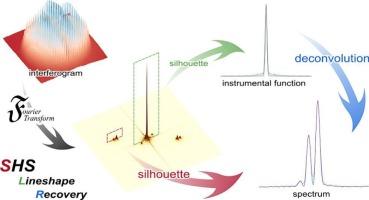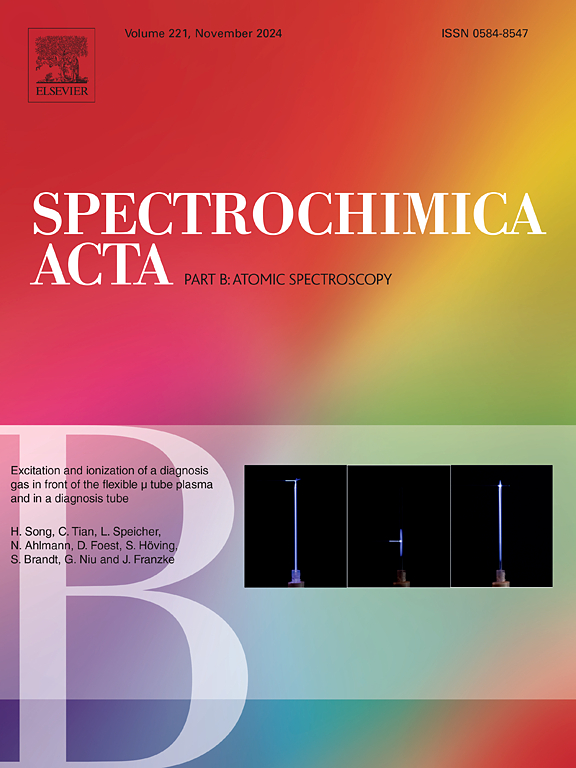Practical high-resolution spectroscopy with a spatial heterodyne spectrometer: Determination of instrumental function for lineshape recovery
IF 3.2
2区 化学
Q1 SPECTROSCOPY
引用次数: 0
Abstract
The spatial heterodyne spectrometer (SHS) is a well-recognized platform for its high resolving power in various use cases of spectroscopy. Same as other spectrometer topologies, the SHS, unfortunately, also suffers from classical challenges such as distorted lineshape due to the instrumental function. The goal of this work is to tackle this persisting issue through a simple numerical approach. With the inherent characteristics of an SHS interferogram, we report the direct extraction and determination of the instrumental function in its numerical representation from an SHS interferogram; this instrumental function was further used for spectral data processing that enables significant improvements in spectral resolution through deconvolution algorithms.
Here, we systematically discuss the recognition of the embedded instrumental function among various ingredients within an interferogram. To verify the numerical approach, lithium was chosen as the model sample, resembling the use of SHS in an isotopic analysis application. Specifically, the resonance transition of lithium D-lines (2P1/2,3/2 ← 2S1/2) was selected to assess the performance of the spectral processing. With the spectral deconvolution, the spectral features that represent the 6Li and 7Li were nearly baseline-separated, allowing for the accurate measure of the isotopic abundance without external references or algorithm adjustments (e.g., curve fitting).

利用空间外差分光计进行实用高分辨率光谱分析:确定线形恢复的仪器功能
空间外差分光计(SHS)是一种公认的平台,在光谱学的各种应用案例中具有高分辨率。遗憾的是,与其他光谱仪拓扑结构一样,空间异频光谱仪也面临着传统的挑战,如仪器功能导致的线形失真。这项工作的目标是通过简单的数值方法来解决这一长期存在的问题。利用 SHS 干涉图的固有特征,我们报告了从 SHS 干涉图中直接提取和确定仪器函数的数值表示方法;这一仪器函数被进一步用于光谱数据处理,通过去卷积算法显著提高了光谱分辨率。为了验证数值方法,我们选择锂作为模型样本,这与同位素分析应用中使用 SHS 相似。具体来说,选择锂 D 线的共振转变(2P1/2,3/2 ← 2S1/2)来评估光谱处理的性能。通过光谱解卷积,代表 6Li 和 7Li 的光谱特征几乎基线分离,无需外部参考或算法调整(如曲线拟合)即可准确测量同位素丰度。
本文章由计算机程序翻译,如有差异,请以英文原文为准。
求助全文
约1分钟内获得全文
求助全文
来源期刊
CiteScore
6.10
自引率
12.10%
发文量
173
审稿时长
81 days
期刊介绍:
Spectrochimica Acta Part B: Atomic Spectroscopy, is intended for the rapid publication of both original work and reviews in the following fields:
Atomic Emission (AES), Atomic Absorption (AAS) and Atomic Fluorescence (AFS) spectroscopy;
Mass Spectrometry (MS) for inorganic analysis covering Spark Source (SS-MS), Inductively Coupled Plasma (ICP-MS), Glow Discharge (GD-MS), and Secondary Ion Mass Spectrometry (SIMS).
Laser induced atomic spectroscopy for inorganic analysis, including non-linear optical laser spectroscopy, covering Laser Enhanced Ionization (LEI), Laser Induced Fluorescence (LIF), Resonance Ionization Spectroscopy (RIS) and Resonance Ionization Mass Spectrometry (RIMS); Laser Induced Breakdown Spectroscopy (LIBS); Cavity Ringdown Spectroscopy (CRDS), Laser Ablation Inductively Coupled Plasma Atomic Emission Spectroscopy (LA-ICP-AES) and Laser Ablation Inductively Coupled Plasma Mass Spectrometry (LA-ICP-MS).
X-ray spectrometry, X-ray Optics and Microanalysis, including X-ray fluorescence spectrometry (XRF) and related techniques, in particular Total-reflection X-ray Fluorescence Spectrometry (TXRF), and Synchrotron Radiation-excited Total reflection XRF (SR-TXRF).
Manuscripts dealing with (i) fundamentals, (ii) methodology development, (iii)instrumentation, and (iv) applications, can be submitted for publication.

 求助内容:
求助内容: 应助结果提醒方式:
应助结果提醒方式:


